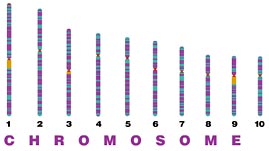Inside every one of our cells (except red blood cells) is a nucleus
containing 23 pairs of chromosomes. These chromosomes are built from
long strands of a ladder-shaped molecule called deoxyribonucleic
acid (DNA). The DNA molecule, in turn, is made up of many smaller
components. These nucleotides, or bases, pair up to form the rungs of the
DNA ladder. Although there are only four different types of nucleotides
in DNA (usually referred to by the first letter of their chemical name,
A, T, C, and G), these molecules, repeated 3 billion times in the human
genome, carry the instructions required to build our bodies and regulate
our functions.
Usually, nucleotides are not particularly meaningful on their
own. Combined, however, specific sequences of nucleotides -- ATTTCG, for
example -- spell out the genetic instructions for building proteins. A
gene is one such sequence, one section of a chromosome that provides the
code that influences a trait -- like eye color, for instance. (Scientists
believe that three or more genes interact to determine a person's
eye color.)
Locating genes that influence specific physical traits among the 3 billion
nucleotides in the human genome is a notoriously difficult task. To
find genes, researchers often try to correlate physical differences with
genetic differences. Genetic diseases are often caused by striking genetic
differences, so one method gene hunters use is to compare the DNA of
people who have a disorder with those who do not. When a scientist finds
differences in DNA sequences between these groups, they have a clue to
one possible culprit in the disease. Other methods are used to identify
genes not implicated in disease. They include computational methods such
as comparing human DNA sequences to those in animals that have been well
studied and in which many genes have been identified. Current estimates
of human genes are about 30,000-40,000, but the functions of the vast
majority of these remain unknown.

 Loading Standards
Loading Standards Teachers' Domain is proud to be a Pathways portal to the National Science Digital Library.
Teachers' Domain is proud to be a Pathways portal to the National Science Digital Library.
